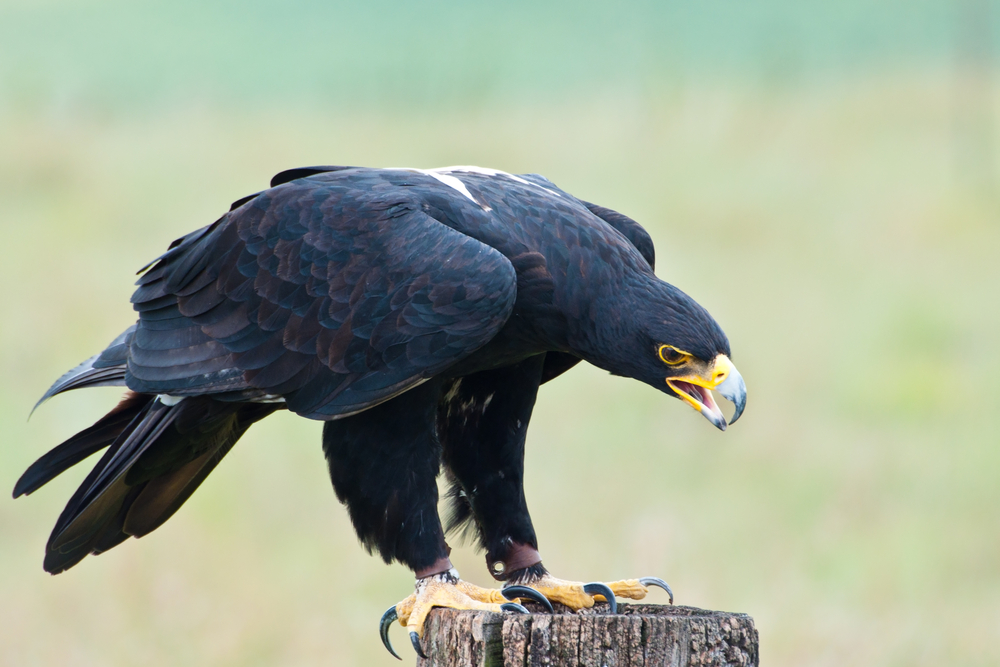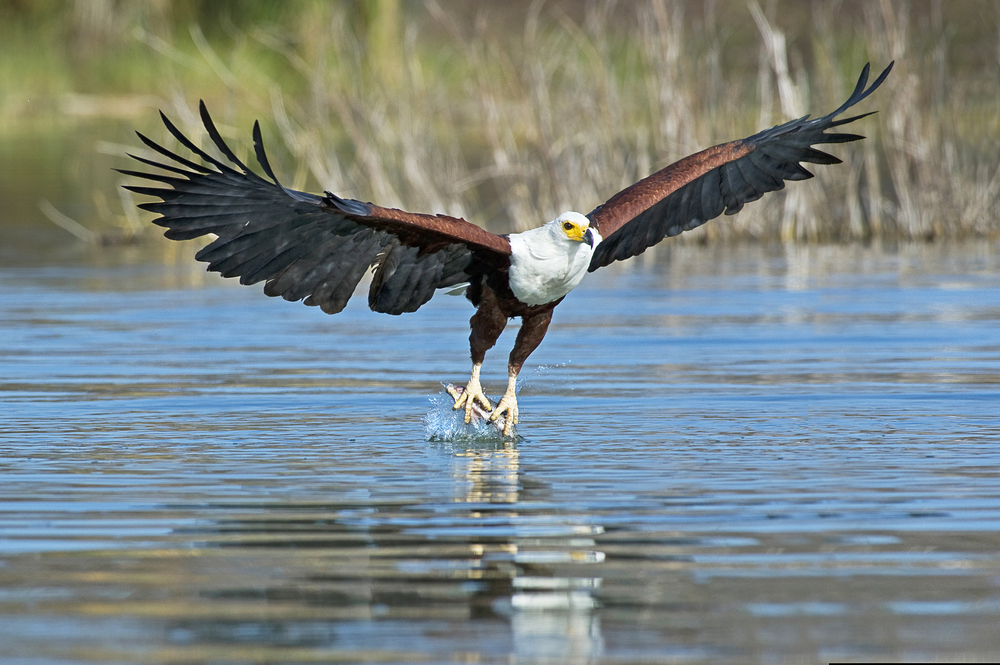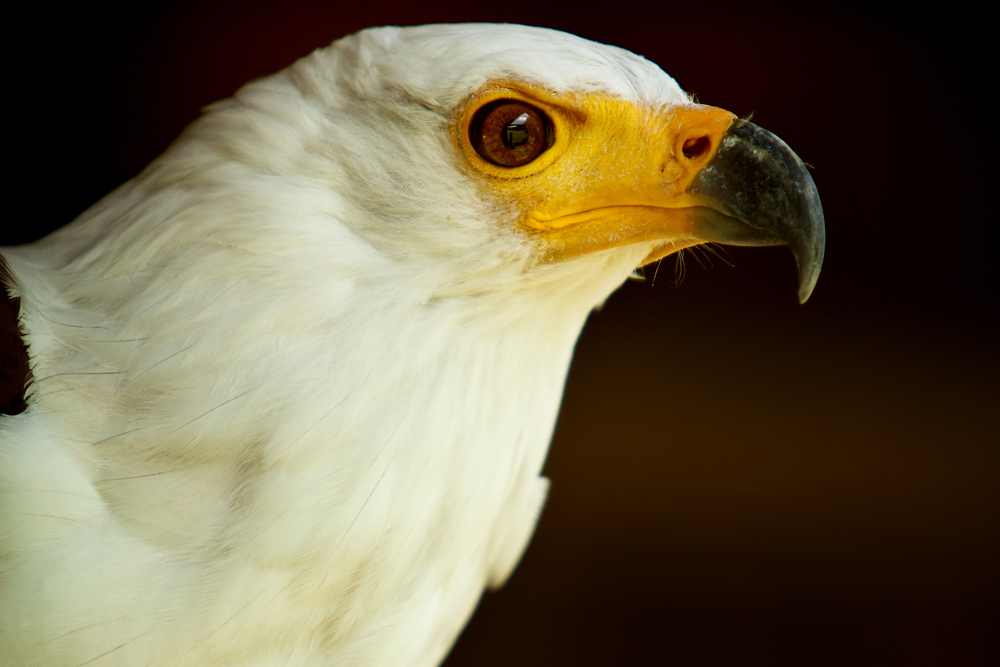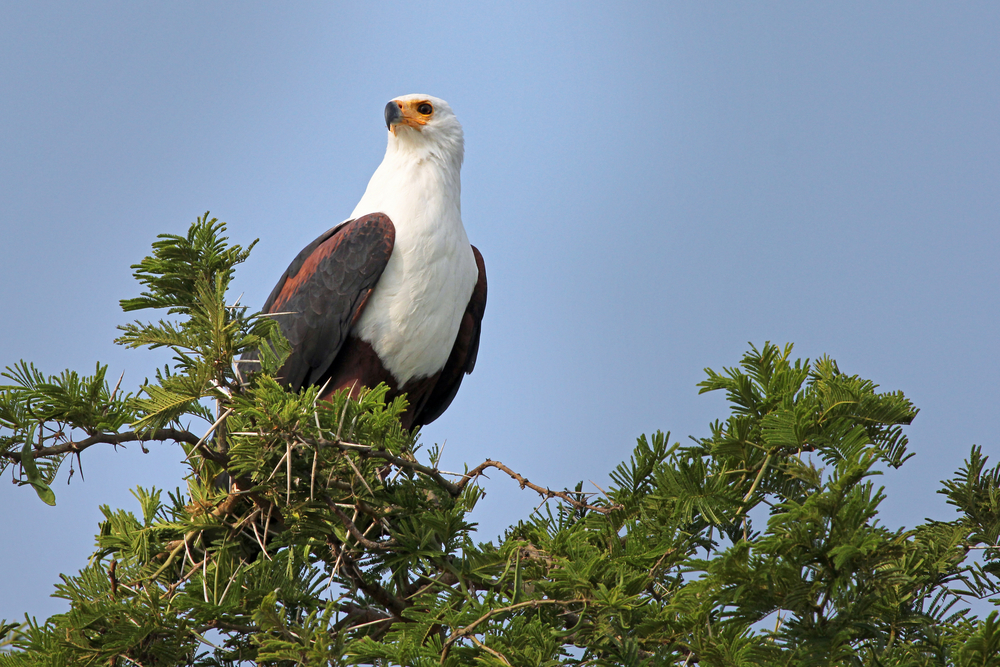About
The African Fish Eagle, scientifically known as Haliaeetus vocifer, is a magnificent bird of prey renowned for its striking appearance and formidable hunting prowess. Belonging to the family Accipitridae, which includes eagles, hawks, and kites, the African Fish Eagle holds a prominent position in the Animal Kingdom as a top avian predator.
With its distinctive white head, neck, and tail contrasting against its dark brown body, the African Fish Eagle is easily recognizable. It possesses a sharp, curved beak and powerful talons, ideal for grasping and capturing its aquatic prey. This majestic bird has a wingspan that can exceed two meters, enabling it to soar gracefully over lakes, rivers, and wetlands in search of food.
African Fish Eagles are predominantly found near freshwater habitats throughout sub-Saharan Africa, including lakes, rivers, and estuaries. They are often observed perched on branches or tree limbs overlooking bodies of water, where they patiently await opportunities to hunt. These eagles are skilled fishermen, using their keen eyesight to spot fish near the water’s surface before swooping down to snatch them with their talons.
As their name suggests, African Fish Eagles primarily feed on fish, which make up the majority of their diet. They are adept hunters, capable of catching fish of various sizes, including tilapia, catfish, and even small crocodiles. After capturing their prey, African Fish Eagles will often return to a favored perch to consume their meal, tearing it apart with their powerful beak and talons.
Conservation Status
The conservation status of the African Fish Eagle is of least concern according to the International Union for Conservation of Nature (IUCN) Red List. However, like many other bird species, African Fish Eagles face threats such as habitat loss, pollution, and human disturbance. Efforts to conserve their freshwater habitats and mitigate human-induced pressures are crucial for ensuring the continued survival of these iconic raptors in Africa’s ecosystems.
Physical Characteristics
The African Fish Eagle (Haliaeetus vocifer) is a majestic bird of prey renowned for its distinctive appearance and impressive hunting skills:
Size and Weight:
- Wingspan: African fish eagles have an impressive wingspan averaging around 6 to 8 feet (1.8 to 2.4 meters), allowing them to soar gracefully above water bodies.
- Length: They measure approximately 26 to 31 inches (66 to 79 centimeters) in body length.
- Weight: Adults typically weigh between 4.4 to 6.6 pounds (2 to 3 kilograms), with females being slightly larger than males.
Physical Characteristics:
- White Head and Tail: The African fish eagle exhibits a striking white head and tail feathers, contrasting sharply with its dark brown body plumage.
- Powerful Beak: It possesses a strong, hooked beak ideally suited for tearing flesh from its prey, particularly fish caught from the water’s surface.
- Yellow Eyes: African fish eagles have distinctive yellow eyes that provide excellent vision, aiding them in locating prey from afar.
- Sharp Talons: Their powerful feet are equipped with sharp talons, enabling them to grasp and carry prey securely while in flight.
- Plumage Patterns: Adults display a mix of brown and white plumage, with juveniles having more mottled coloring until they reach maturity.
These unique physical characteristics, combined with their keen eyesight and agile flight capabilities, make the African fish eagle an apex predator in its habitat, perfectly adapted for hunting and survival in freshwater ecosystems
Reproduction
The reproductive cycle of the African Fish Eagle is intricately linked to its habitat and food availability. Here’s an overview:
Breeding Season: African Fish Eagles typically breed during the dry season when water levels are lower, and fish are concentrated in smaller water bodies. The exact timing varies depending on the region but often occurs from April to August.
Courtship and Pair Bonding: During the breeding season, pairs of African Fish Eagles engage in elaborate courtship displays, including aerial acrobatics, vocalizations, and ritualized feeding displays.
Nest Building: Once the pair bonds are established, the eagles construct large stick nests in tall trees near water bodies. These nests are often reused year after year and can reach substantial sizes.
Egg Laying and Incubation: African Fish Eagles typically lay one to three eggs, although two is most common. The incubation period lasts around 42 to 45 days, during which both parents take turns incubating the eggs.
Hatching and Chick Development: The chicks hatch asynchronously, with the first-born being larger and more dominant. The parents provide regurgitated food to the chicks, with the larger chick often receiving more food and having a higher chance of survival.
Fledging: The chicks fledge at around 70 to 80 days old but may remain dependent on their parents for several more weeks. During this time, they learn to hunt and fish under their parents’ guidance.
Dispersal and Independence: Once the chicks become independent, they disperse from the nesting territory to establish their own territories or find mates. This dispersal helps prevent inbreeding and maintains genetic diversity within the population.
Reproductive Success and Parental Care: Successful breeding depends on factors like food availability, nest site quality, and parental care. Both parents invest significant time and effort in raising their offspring, ensuring their survival and reproductive success.
The reproductive cycle of the African Fish Eagle reflects its dependence on aquatic habitats and fish as a primary food source. This majestic bird’s breeding behaviors are finely tuned to exploit seasonal changes in its environment.
Lifespan
The African Fish Eagle, renowned for its distinctive call and majestic appearance, is a species of large eagle found near freshwater habitats across sub-Saharan Africa. With its characteristic white head, brown body, and hooked beak, this eagle is an iconic symbol of African rivers and lakes. Here’s an overview of the African Fish Eagle’s lifespan and the threats it faces:
Wild Lifespan: In the wild, African Fish Eagles typically live for about 12 to 24 years, although some individuals have been known to live longer under optimal conditions. However, their lifespan in the wild can be significantly impacted by various threats and environmental factors.
Lifespan in Captivity: In captivity, African Fish Eagles may have a longer lifespan compared to their wild counterparts. With access to consistent food, veterinary care, and protection from natural predators, captive individuals can live up to 30 years or more. However, their lifespan in captivity can still be influenced by factors such as diet, habitat enrichment, and overall husbandry practices.
Threats to African Fish Eagles:
- Habitat Loss: Destruction and degradation of wetland habitats due to human activities such as deforestation, urbanization, and agriculture pose a significant threat to African Fish Eagles. Loss of nesting sites and food sources can lead to population declines.
- Pollution: Contamination of freshwater ecosystems with pollutants such as pesticides, heavy metals, and plastics can impact fish populations, reducing prey availability for African Fish Eagles. Ingestion of toxic substances can also directly harm the birds.
- Human Disturbance: Human activities such as boating, fishing, and recreational use of waterways can disturb nesting sites and disrupt breeding behavior. Noise pollution and disturbance from human activities may also stress the birds and affect their reproductive success.
- Poaching and Persecution: African Fish Eagles may be targeted by poachers for their feathers, body parts, or as perceived competitors with fishermen. Illegal hunting, trapping, and persecution by humans pose a direct threat to the species’ survival.
- Climate Change: Climate variability and changes in weather patterns can affect the availability of prey species and alter the distribution of suitable habitat for African Fish Eagles. Rising temperatures and shifts in precipitation patterns may impact their breeding success and overall population health.
Conservation efforts focused on habitat protection, pollution mitigation, and education about the importance of wetland ecosystems are essential for safeguarding the African Fish Eagle and ensuring its long-term survival in the wild.
Eating Habits
The African fish eagle (Haliaeetus vocifer) is a majestic bird of prey found near freshwater habitats across sub-Saharan Africa. Known for its striking appearance and powerful hunting prowess, the African fish eagle has distinct feeding habits tailored to its aquatic lifestyle and diet.
Diet: As its name suggests, the African fish eagle is primarily piscivorous, meaning it predominantly feeds on fish. Fish make up the majority of its diet, and the eagle often targets various species found in freshwater bodies such as lakes, rivers, and coastal regions. While fish comprise the mainstay of its diet, African fish eagles may also opportunistically feed on other aquatic prey such as crustaceans, frogs, and occasionally small mammals or birds.
Hunting Technique: African fish eagles employ several hunting techniques to catch fish. One common method involves perching on a high vantage point overlooking the water, from where they scan the surface for potential prey. When a suitable target is spotted, the eagle swoops down with impressive speed and agility, extending its talons to snatch the fish from the water’s surface. Alternatively, African fish eagles may engage in aerial pursuits, chasing after flying fish or scavenging from other predators’ catches.
Habitat Selection: African fish eagles are commonly found near large bodies of freshwater, including lakes, rivers, reservoirs, and estuaries. These habitats provide abundant fish populations and offer ideal hunting grounds for the eagles to fulfill their dietary needs. The eagles often establish territories encompassing stretches of water where they can hunt efficiently and defend against intruders.
Feeding Behavior: After capturing prey, African fish eagles typically return to a nearby perch to consume their meal. They may tear apart larger fish using their powerful beaks and talons before consuming smaller pieces. If the prey is too large to carry, the eagle may drag it to a safe location onshore or into shallow water to feed at its leisure.
Scavenging Behavior: In addition to hunting, African fish eagles are known to scavenge for food, especially when fish are scarce or when opportunities arise near human settlements or fishing activities. They may steal fish from other birds or scavenge from carcasses left by larger predators, demonstrating their adaptability and opportunistic feeding behavior.
Role in Ecosystem: African fish eagles play a crucial role in aquatic ecosystems by regulating fish populations and contributing to nutrient cycling through predation and scavenging. As apex predators, they help maintain the balance of freshwater ecosystems and contribute to the overall health and functioning of their habitats.
Conclusion: The eating habits of the African fish eagle reflect its specialized adaptation to an aquatic environment and its reliance on fish as a primary food source. Through its hunting prowess, opportunistic feeding behavior, and role as a top predator, the African fish eagle exemplifies the intricate ecological relationships that govern freshwater ecosystems in Africa.
Uniqueness
The African Fish Eagle is a striking and powerful bird, revered as one of the most iconic raptors across sub-Saharan Africa. Here are some key aspects that make the African Fish Eagle unique:
Distinctive Call: One of the most remarkable features of the African Fish Eagle is its loud, ringing call, often described as the “sound of Africa.” This call is especially resonant over the water bodies where it dwells, symbolizing wilderness and freedom.
Impressive Appearance: The African Fish Eagle is easily recognizable by its striking contrast in colors. It has a mostly brown body with a deep, rich brown chest, and starkly white head and tail. The face also features a distinctive black mask around its sharp yellow eyes.
Diet and Hunting Skill: As its name suggests, this eagle predominantly feeds on fish. It possesses incredible skill in swooping down over water to snatch fish with its large, powerful talons. Besides fish, it also hunts birds, small mammals, and even carrion.
Habitat Specialization: This eagle is commonly found near freshwater lakes, rivers, reservoirs, and along some coastlines. The availability of perches such as trees or cliffs nearby water bodies is crucial for it to watch over its territory and spot potential prey.
Mate for Life: The African Fish Eagle is monogamous and pairs mate for life. Together, they build large nests in tall trees or on cliffs overlooking water, and these nests can be reused and added to each year.
Symbolic Importance: This eagle is not only a symbol of the wild African landscapes but also holds emblematic status in various countries. For instance, it appears on the coat of arms of Namibia and Zambia, highlighting its cultural significance.
Conservation Status: The African Fish Eagle plays a vital role in its ecosystem, helping to control fish populations and being a strong indicator of water quality. Its presence and health can signal changes in the aquatic ecosystem, making it an important species for conservation efforts.
The African Fish Eagle’s majestic appearance, powerful presence, and evocative call make it a unique and beloved symbol of Africa’s rich biodiversity. Its role in the ecosystem underscores the interconnectedness of species and habitats, enhancing its significance in nature conservation.


















































































